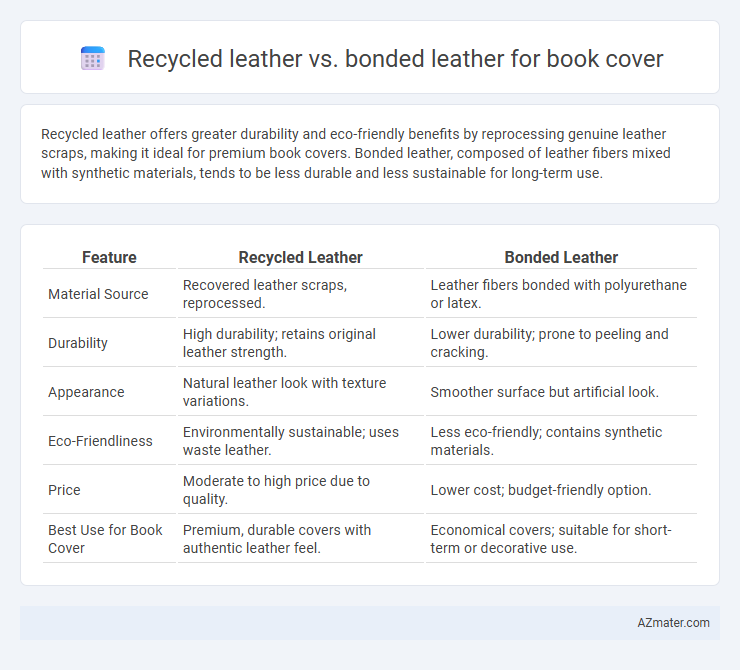Recycled leather offers greater durability and eco-friendly benefits by reprocessing genuine leather scraps, making it ideal for premium book covers. Bonded leather, composed of leather fibers mixed with synthetic materials, tends to be less durable and less sustainable for long-term use.
Table of Comparison
| Feature | Recycled Leather | Bonded Leather |
|---|---|---|
| Material Source | Recovered leather scraps, reprocessed. | Leather fibers bonded with polyurethane or latex. |
| Durability | High durability; retains original leather strength. | Lower durability; prone to peeling and cracking. |
| Appearance | Natural leather look with texture variations. | Smoother surface but artificial look. |
| Eco-Friendliness | Environmentally sustainable; uses waste leather. | Less eco-friendly; contains synthetic materials. |
| Price | Moderate to high price due to quality. | Lower cost; budget-friendly option. |
| Best Use for Book Cover | Premium, durable covers with authentic leather feel. | Economical covers; suitable for short-term or decorative use. |
Introduction to Recycled and Bonded Leather
Recycled leather consists of genuine leather fibers that are shredded and reprocessed to create a sustainable material often used for durable book covers. Bonded leather is made by combining leather scraps with a polyurethane or latex backing, offering a cost-effective and leather-like appearance for cover applications. Both materials provide eco-friendly alternatives to traditional leather, though recycled leather tends to have higher durability and authenticity in texture.
What is Recycled Leather?
Recycled leather is created by processing leftover leather scraps and fibers, which are combined with a binding agent to form a new material that closely resembles genuine leather. This sustainable option reduces waste by repurposing offcuts from garment and furniture production, offering durability and a natural texture ideal for book covers. Compared to bonded leather, recycled leather maintains higher strength and breathability, enhancing the protective qualities and aesthetic appeal of book bindings.
What is Bonded Leather?
Bonded leather is a material made by combining shredded leather scraps with a polyurethane or latex binder, then pressing the mixture onto a fiber backing to create a leather-like surface. It offers an affordable and eco-friendly alternative to genuine leather but tends to be less durable and more prone to peeling and cracking over time. For book covers, bonded leather provides a smooth texture and leather appearance but may not withstand frequent handling as well as higher-quality leather types like recycled or full-grain leather.
Production Processes Compared
Recycled leather is produced by shredding and reconstituting scrap leather fibers mixed with polyurethane or latex binders, resulting in a durable and eco-friendly material. Bonded leather is manufactured by combining shredded leather scraps with a polyurethane or latex coating, then embossing it to mimic genuine leather's texture, often containing less natural leather content. The key difference lies in recycled leather's higher content of natural leather fibers and environmentally sustainable use of waste, while bonded leather primarily emphasizes cost efficiency and uniform appearance.
Durability and Longevity
Recycled leather, made from reclaimed leather fibers combined with a binding agent, offers moderate durability ideal for short- to medium-term use, but may show wear over time compared to genuine leather. Bonded leather consists of leather scraps bonded with polyurethane or latex, resulting in lower durability and a higher risk of peeling or cracking when subjected to frequent handling. For book covers requiring long-term resilience, recycled leather generally provides better longevity and resistance to wear compared to bonded leather.
Aesthetic and Texture Differences
Recycled leather offers a more natural grain and subtle texture, enhancing the aesthetic appeal of book covers with authentic leather patterns and slight imperfections. Bonded leather typically has a smoother, more uniform finish due to its composite nature, often displaying a synthetic appearance with less texture variation. The tactile experience of recycled leather feels richer and more supple, while bonded leather tends to be stiffer and less breathable, impacting both look and feel on book covers.
Environmental Impact Assessment
Recycled leather for book covers significantly reduces waste by repurposing post-consumer leather scraps, lowering landfill contributions and minimizing chemical usage compared to bonded leather, which often blends leather fibers with synthetic adhesives and plastics that hinder biodegradability. Life cycle assessments show recycled leather has a smaller carbon footprint due to less intensive processing and reduced raw material extraction, while bonded leather's reliance on polyurethane or vinyl coatings increases its environmental burden. Choosing recycled leather supports sustainable material cycles and enhances eco-friendly book production through improved resource efficiency and waste reduction.
Cost Comparison for Book Covers
Recycled leather typically costs more than bonded leather due to its higher-quality materials and more sustainable production processes, making it a durable but pricier choice for book covers. Bonded leather is a budget-friendly alternative, made from leather scraps mixed with synthetic materials, resulting in lower production costs and more affordable pricing. Choosing between recycled and bonded leather for book covers depends largely on balancing durability preferences with budget constraints.
Best Use Cases for Each Material
Recycled leather is ideal for premium book covers requiring durability and authentic leather texture, offering an eco-friendly option made from repurposed leather scraps. Bonded leather, composed of leather fibers mixed with polyurethane, suits budget-friendly book covers where aesthetic appeal is prioritized over longevity and frequent handling. Selecting recycled leather enhances sustainability and longevity for collectible editions, while bonded leather fits best in mass-produced books with moderate use.
Choosing the Right Leather for Your Book Cover
Recycled leather, made from shredded leather scraps bonded with polyurethane, offers durability and a genuine leather feel, making it ideal for premium book covers seeking an eco-friendly yet authentic appearance. Bonded leather, composed mainly of leather fibers mixed with synthetic materials and adhesive, provides a cost-effective option with less durability and a more artificial look, suitable for budget-conscious projects. Choosing the right leather depends on balancing factors such as longevity, texture, environmental impact, and budget to enhance the book cover's aesthetic and functional appeal.

Infographic: Recycled leather vs Bonded leather for Book cover
 azmater.com
azmater.com